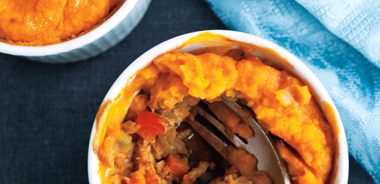Shepherd's Pie

Shepherd’s pie has two names: traditionally called cottage pie, it was made with beef, while shepherd’s pie was made with lamb. These English/Irish dishes were made with leftover roasted meat, chopped finely, and whatever mashed potatoes and cooked vegetables were left over from Sunday night dinner.
To put a healthier spin on this dish, I substituted extra-lean chicken mince for the lamb or beef and sweet potatoes for regular white potatoes.
Whichever way you make it, this dinner is economical and easy to make, especially if you are using leftover cooked vegetables. Serve with a tossed green salad.
3 sweet potatoes to equal 2 1/2 cups (625 ml) cooked, mashed sweet potatoes
3 tsp (15 ml) butter (optional)
3 tsp (15 ml) extra-virgin olive oil
1 medium onion, diced
450 g (1 lb) extra-lean free-range chicken mince
4 garlic cloves, minced
3 tsp (15 ml) fresh rosemary, minced
1 tsp (5 ml) cracked black pepper
1/4 cup (60 ml) low-salt tomato sauce
3 tsp (15 ml) Worcestershire sauce
2 cups (500 ml) leftover cooked vegetables or thawed frozen vegetables of your choice
Peel and boil sweet potatoes in water in covered pot. When cooked, cool, then mash. Add butter if using and mash lightly. Set aside. If using leftover sweet potatoes, simply mash and set aside.
Preheat oven to 190 C. Lightly oil 9 x 9 x 2 in/23 x 23 x 5 cm (2.5 L) baking dish. Set aside.
Heat large frying pan over medium heat; add oil and onion, and sauté until onion is soft, approximately 3 to 5 minutes. Add minced chicken, breaking up meat as you cook it. Continue cooking until meat is no longer pink; pour off any excess fat.
Add garlic, rosemary and pepper and sauté for 2 minutes. Add tomato sauce and Worcestershire sauce and stir until well combined. Add vegetables and stir in well. Pour into prepared pan. Evenly spoon mashed sweet potatoes over top. Bake for 30 minutes or until mixture is heated through.
Makes 6 servings.
Each serving contains: 1000 kilojoules; 15 g protein; 10.5 g total fat (6 g sat. fat, 0 g trans fat); 23 g carbohydrates; 4 g fibre; 148 mg salt.
source: "Homemade and Man-Made", from alive Australia Winter 2012




